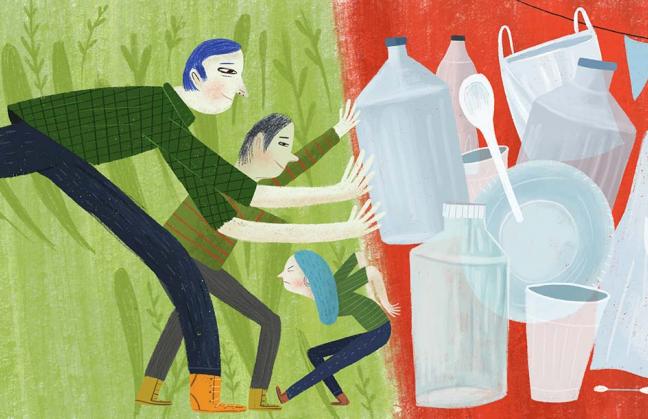No Plastic Bags, Please!
If the problem of plastic waste is so enormous, why are we still using this material?

I shut the front door, but almost immediately realize I’ve forgotten something – my reusable shopping bags! I mustn’t forget them. Once they are firmly in my hands, we’re ready to go grocery shopping. After going up and down the aisles and making sure I’ve got everything on my list, we’re ready to leave. This is when, as I’m sure has happened to you, in a moment of distraction half your purchases have already been packed in plastic bags. I immediately ask them to take everything out and put it in the reusable bags I brought with me. All of this effort aims to reduce the use of plastic at home and, even though it might not seem much, it is.
But, have you ever wondered how much plastic are you carrying in those fabric bags you made sure were used to pack your groceries? In other words, how many of the products you bought were either manufactured or packaged, even partially, in this material? Just imagine that, according to SEDEMA (Ministry of the Environment), in 2017, just one person in Mexico City generated an approximate total of 1.37 kilograms of solid waste every day, which translates into a daily total of 12,998 tons. However, in this city only 5%, more or less, is recycled.
If the problem of plastic waste generated is so enormous, why are we still using this material? Actually, even if they wanted to, nobody can refute its benefits. Not only is it inexpensive, but also easy to manufacture and, in particular, lightweight.
Thus, if plastic has so many advantages, why does it produce so much opposition? In May, a reform to the Mexico City solid waste act was approved, prohibiting the sale and distribution of single-use plastics. No more disposable straws, cutlery, plates and cups, let alone plastic grocery bags, as of 2021. The only single-use plastics that will be allowed, and in the absence of compostable alternatives, will be those that serve to assure food hygiene and preservation.
The most important problem related to plastic is that, just like the issues mentioned beforehand, it was manufactured for a single use and once it has passed through our hands, its useful life comes to an end. The amounts of this type of plastic are unimaginable. According to the United Nations, approximately 38% of the plastic produced worldwide every year is used to package other products and most of it will be thrown away immediately. This same organization also calculated that, at this rate of consumption, by 2050 there will be 13 billion tons of plastic on Earth, either in landfills or just floating around.
In this regard, prohibition has produced numerous arguments from both sides. On the one hand, there are those who support this type of initiatives and would probably agree with even stricter policies. On the other, are those that highlight the negative effects on the economy. They claim that the new law will result in job losses related to the collection of this waste, as well as a loss of income for companies that won’t have time to adjust processes and technology, among other elements of their business model. What makes this matter so complex is that both sides are right to some extent.
The problem of plastic, and in particular single-use plastic, is that many aspects are interrelated and interdependent. Once one element of the system is touched on, there will be effects on many others. According to a United Nations report, prohibitions and levies have recently been adopted by approximately 60 countries, only about half of which have documented results. Of these, 30% have reported being successful, while 20% have detected no significant changes. This gives us an idea of the need for complementary actions in order to be able to reach the desired goals.
Government intervention in regulations can be necessary to combat the issues, but developing incentive systems that promote and support the creation of business models aligned with a circular economy is also imperative. The company Biofase is an excellent example of this type of models in which the use of a material that would otherwise have ended up in the garbage, avocado seeds, generates a new product that, at the end of its useful life, will degrade more easily, thus reducing its environmental impact. It is important to analyze the timeframes for the application of the new regulation to understand the impact on the activities of the sectors directly or indirectly affected by it.
Private enterprise also needs to invest in Research and Development to find alternatives to this very popular material or to find ways, regardless of its use, to achieve the substantial reduction of its environmental impact. In this regard, there are already significant initiatives, such as that of the National Association of Plastic Industries (ANIPAC), which brings together the principal actors from the sector to join forces in this effort. Alliances will be a highly useful tool to create synergies in this matter.
Another important dimension is society. We can prohibit everything we like, but if we users are not aware of the relevance of our own actions in the solution of this issue, someone will undoubtedly find a way to break the rules. As a matter of fact, the lack of enforcement has been one of the most frequently mentioned reasons for the failure of regulation. Therefore, we need to understand that the issue of plastic involves all of us, government, companies and society, and, therefore, we must join forces to play a role in its solution.
Whatever the fate and use of plastic may be, something that this case teaches us is the imperative of adopting corporate sustainability in organizational strategy. Corporate sustainability is essential to prepare organizations to address this type of situation, but, above all, it has the potential to provide the necessary bases to stay one step ahead and reduce the associated risks. The relevant issues for companies range from the stakeholder management in order to understand what they need and how we can generate more value together, to the analysis and identification of the issues that we need to tackle within social responsibility initiatives. Once it has been adopted as a way of doing business, corporate sustainability will help us avoid any surprises that could jeopardize our organizations’ economic activity.



